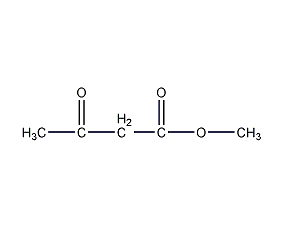
Structural formula
| Business number | 02RQ |
|---|---|
| Molecular formula | C5H8O3 |
| Molecular weight | 116 |
| label |
Aliphatic carboxylic acids and their derivatives |
Numbering system
CAS number:105-45-3
MDL number:MFCD00008784
EINECS number:203-299-8
RTECS number:AK5775000
BRN number:506727
PubChem ID:None
Physical property data
1. Properties: Colorless and transparent liquid with aromatic smell.
2. Density (g/mL, 20/4℃): 1.0762
3. Melting point (ºC): -80
4. Boiling point (ºC , normal pressure): 172
5. Refractive index (20ºC): 1.4184
6. Viscosity (mPa·s, 20ºC): 1.704
7. Flash point (ºC, closed): 82
8. Heat of evaporation (KJ/mol): 36.00
9. Heat of combustion (KJ/mol): 3155.2
10. Vapor pressure (kPa, 25ºC): 0.8
11. Solubility: Slightly soluble in water, easily soluble in organic solvents.
12. Liquid phase standard hot melt (J·mol-1·K-1): 200.7
Toxicological data
1. Skin/eye irritation: Start irritation test: rabbit skin contact, 10mg/24H; Standard Dresser test: rabbit skin contact, 500mg/24HREACTION SEVERITY, slight reaction; Standard Dresser test: rabbit eye contact, 2mgREACTION SEVERITY , strong reaction; 2. Acute toxicity: rat oral LD50: 3228mg/kg; 3. It is corrosive to the skin, so care should be taken to protect the skin.
Ecological data
This substance is slightly hazardous to water.
Molecular structure data
1. Molar refractive index: 27.01
2. Molar volume (cm3/mol): 111.6
3. Isotonic specific volume (90.2K ): 260.8
4. Surface tension (dyne/cm): 29.7
5. Dielectric constant:
6. Dipole moment (10-24cm3):
7. Polarizability: 10.71
Compute chemical data
1. Reference value for hydrophobic parameter calculation (XlogP): 0
2. Number of hydrogen bond donors: 0
3. Number of hydrogen bond acceptors: 3
4. Number of rotatable chemical bonds: 3
5. Number of tautomers: 5
6. Topological molecule polar surface area 43.4
7. Number of heavy atoms: 8
8. Surface charge: 0
9. Complexity: 106
10. Number of isotope atoms: 0
11. Determine the number of atomic stereocenters: 0
12. Uncertain number of atomic stereocenters: 0
13. Determine the number of stereocentersNumber of � bond stereocenters: 0
14. Number of uncertain chemical bond stereocenters: 0
15. Number of covalent bond units: 1
Properties and stability
1. Avoid contact with oxidants. It is a flammable substance. In case of fire, water spray, powder fire extinguishing agent, carbon dioxide, etc. can be used to extinguish the fire.
Chemical properties: It turns dark red when exposed to ferric chloride. Boiled with water it decomposes into acetone, methanol and carbon dioxide.
2.This product is less toxic, with an oral LD of 503.0g/kg in rats. In the test of rats exposed to concentrated steam for 8 hours, no death was found. Moderately irritating and narcotic. Equipment sealing and ventilation in the operating area should be strengthened. Operators wear protective equipment.
Storage method
1. Store in a cool, ventilated warehouse. Keep away from fire and heat sources. They should be stored separately from oxidants and strong alkali, and avoid mixed storage. Equipped with the appropriate variety and quantity of fire equipment. The storage area should be equipped with emergency release equipment and suitable containment materials.
2. This product is packed in aluminum drums. Make sure the lid is well sealed. Store in a cool and ventilated place. Fireproof. Store and transport according to regulations for flammable and toxic chemicals.
Synthesis method
Produced by the reaction of diketene and methanol. Diketene and methanol are esterified using concentrated sulfuric acid as a catalyst, and then the finished product is obtained through crude fractionation and rectification. Diketene is derived from the cleavage of acetic acid.
![]()
Refining method: except for those containing free In addition to acids and alcohols, it also contains impurities such as acetone. During refining, dry with potassium carbonate or anhydrous sodium sulfate and then distill under reduced pressure.
Purpose
Used as a component of cellulose ether ester mixed solvents, used in the synthesis of pyrazolone drugs, vitamin B1, allethrin pesticides and azo dyes, etc., and also used in organic synthesis of medicines, pigments, molecular stabilizers, etc. middle.

 微信扫一扫打赏
微信扫一扫打赏

